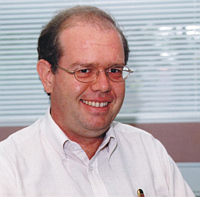since 13th Oct, 2000
(last updated 13th Oct, 2000)
The information supplied here is simply for interest sake. The intent is simply to give a taste of my experience at listening to this lecture.
 Wow, what a great Lecture. I found it particularly interesting as it
combines both my work (PCB designer) & hobby (wondering how antennas work
- ham radio).
Wow, what a great Lecture. I found it particularly interesting as it
combines both my work (PCB designer) & hobby (wondering how antennas work
- ham radio).Dr Andrew Parfitt, who is a boffin at CSIRO radiophysics, presented his lecture "Printed Circuit Antennas and IC Antennas" quite well. He knew his stuff, he answered every question & was enjoyable to listen to. There was essentially no mathematics involved, more just explaining the concepts.
He took us through the basics of half-wave dipoles & slot antennas & then showed us how the basic PCB `patch' antenna is constructed & can be fed on PCB material (microstrip line; direct coaxial fed; & slot fed). He talked about how to feed arrays of these antennas (hence getting a lot of gain from arrays of simple dipoles etc) with an end fed style (similar to a co-linear antenna & not very frequency tolerant - the slight phase change bending the beam) & splitting the feed again & again (some frequency idependance).
He talked about problems concerning radiation patterns being disturbed by different modes propogating along the dielectric (between the patch antenna on the top, and, the ground plane on the bottom of the PCB) & some of the ingenious ways of limiting the deliterious effects of these i.e. using very thin dielectrics; using foam dielectrics with dielectric constants very close to air ~1.0; or using an array of holes in the dielectric `tuned' (size & spacing) to remove the worst of the other modes (frequency sensitive) etc.
He then went on to show how in the true sense of having circuits (amplifiers, combiners) & antennas on a PCB there are some great gains to be made in a commercial sense i.e. having the entire system built in one go - the beauty of PCB's; & also some great problems to overcome e.g. having the radiation disturbing the circuit elements, requiring very specific placement of components w.r.t. the antenna's.
Further to these basics, he went on to show how the same ideas are being put onto silicon substrates instead of PCB's (for the higher wavelengths) & associated gains & problems so far.
I even tried to ask a couple of semi-intelligent questions about `how does the etching tolerance of mainstream PCB manufacturer impinge on the seeming fairly high tolerance needs of creating these PCB antennas?' He suggested buildup technologies (much higher tolerance than etch-down) were the go & they seemed to be giving good results up to around 100GHz. He had shown many different styles of dipole patch antennas including fractal (repeating pattern within patterns) & "bow tie" arrangements & I asked about the advantages of these - their somewhat greater bandwidth (VSWR=2, 20%) compared to the standard `patch' (1%) etc.
There was much more to this lecture, including gain patterns from the arrays, circular polarization & even SWR vs frequency curves, & this has been but a brief overview. I really wish it had been recorded for showing on Gladesville Amateur TV as I'm sure that many amateurs would have been interested & amazed by where these things are headed for the higher frequencies. If you ever get the chance to hear this 1hour overview lecture, jump at it.
5/5
-- Lucent Technologies Dom Bragge (VK2JNA) (INS Multiservice Access - Bell Labs Australia) Senior PCB Designer(R&D) 68 Waterloo Rd North Ryde NSW 2113 IPC Tel: (+61 2) 9491-6523 AUSTRALIA CERTIFIED Fax: (+61 2) 9491-6519 http://www.geocities.com/dom_suz/ PCB DESIGNER